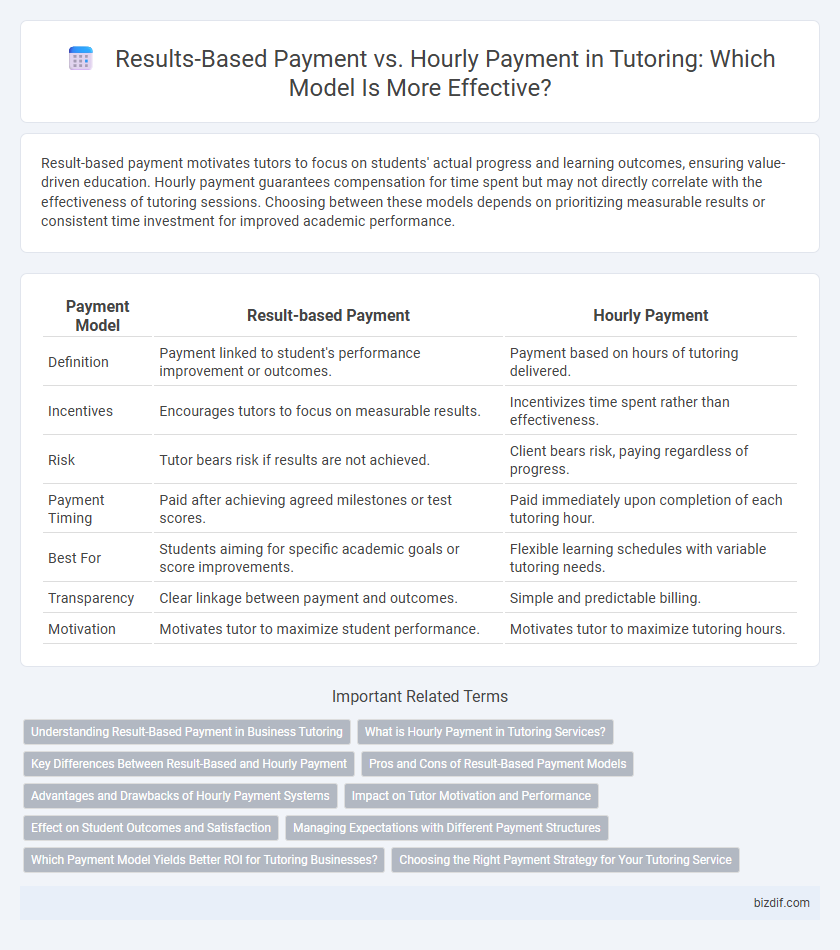Result-based payment motivates tutors to focus on students' actual progress and learning outcomes, ensuring value-driven education. Hourly payment guarantees compensation for time spent but may not directly correlate with the effectiveness of tutoring sessions. Choosing between these models depends on prioritizing measurable results or consistent time investment for improved academic performance.
Table of Comparison
| Payment Model | Result-based Payment | Hourly Payment |
|---|---|---|
| Definition | Payment linked to student's performance improvement or outcomes. | Payment based on hours of tutoring delivered. |
| Incentives | Encourages tutors to focus on measurable results. | Incentivizes time spent rather than effectiveness. |
| Risk | Tutor bears risk if results are not achieved. | Client bears risk, paying regardless of progress. |
| Payment Timing | Paid after achieving agreed milestones or test scores. | Paid immediately upon completion of each tutoring hour. |
| Best For | Students aiming for specific academic goals or score improvements. | Flexible learning schedules with variable tutoring needs. |
| Transparency | Clear linkage between payment and outcomes. | Simple and predictable billing. |
| Motivation | Motivates tutor to maximize student performance. | Motivates tutor to maximize tutoring hours. |
Understanding Result-Based Payment in Business Tutoring
Result-based payment in business tutoring links compensation directly to measurable student achievements, such as improved test scores or successful project completions. This model incentivizes tutors to tailor sessions for maximum impact, aligning teaching strategies with specific business goals. By focusing on tangible outcomes, result-based payments foster accountability and drive higher-quality tutoring performance.
What is Hourly Payment in Tutoring Services?
Hourly payment in tutoring services refers to a compensation model where tutors are paid based on the number of hours they spend teaching a student. This method ensures transparent cost calculation, allowing students and parents to anticipate expenses according to the duration of each session. Tutors benefit from consistent income regardless of immediate student outcomes, emphasizing time and effort over measurable academic results.
Key Differences Between Result-Based and Hourly Payment
Result-based payment in tutoring ties compensation directly to student performance improvements or achievement of specific learning goals, ensuring accountability for measurable outcomes. Hourly payment compensates tutors based on the time spent teaching, regardless of the student's progress or results. Result-based models incentivize quality and effectiveness, while hourly rates prioritize time investment, making the choice dependent on the tutor's and student's priorities.
Pros and Cons of Result-Based Payment Models
Result-based payment models in tutoring incentivize student performance by linking compensation directly to measurable academic improvements, fostering motivation for both tutors and learners. However, these models may overlook individual learning paces and external factors affecting results, potentially leading to undue pressure and inconsistent income for tutors. Balancing performance metrics with personalized education remains crucial to maximizing the effectiveness of result-based payments.
Advantages and Drawbacks of Hourly Payment Systems
Hourly payment systems in tutoring offer flexibility and clear compensation tied directly to time spent, making it easier to track and justify earnings. However, they may encourage quantity over quality, potentially leading to inefficient sessions without guaranteeing improved student outcomes. This method can also create uncertainty for tutors if student engagement fluctuates, impacting their consistent income.
Impact on Tutor Motivation and Performance
Result-based payment in tutoring incentivizes tutors to focus on student progress and achievement, often leading to higher motivation and improved performance as their earnings directly reflect their effectiveness. Hourly payment provides consistent income regardless of outcomes but may result in less drive to enhance teaching methods or engage deeply with student success. Research indicates that tutors compensated based on results tend to adopt more personalized approaches, increasing student engagement and learning outcomes compared to those paid hourly.
Effect on Student Outcomes and Satisfaction
Result-based payment models in tutoring incentivize tutors to focus on measurable student progress, often leading to higher student outcomes and increased satisfaction due to tailored instruction and goal achievement. Hourly payment encourages consistent practice and engagement but may not directly align with student performance improvements, potentially resulting in varied satisfaction levels. Emphasizing outcome-driven compensation fosters accountability and motivates tutors to employ effective teaching strategies that enhance learning efficiency.
Managing Expectations with Different Payment Structures
Result-based payment in tutoring aligns compensation with student performance, incentivizing tutors to focus on measurable progress and goal attainment. Hourly payment provides stable income regardless of outcomes, allowing flexibility but potentially minimizing motivation to exceed expectations. Clear communication of payment structure benefits and limitations upfront helps manage student and tutor expectations, fostering transparency and satisfaction.
Which Payment Model Yields Better ROI for Tutoring Businesses?
Result-based payment models yield better ROI for tutoring businesses by directly aligning compensation with student performance, which incentivizes higher-quality instruction and boosts client satisfaction. Hourly payment structures often lead to fixed revenue irrespective of outcomes, potentially limiting motivation for tutors to exceed standard expectations and reducing overall profitability. Data from tutoring franchises shows a 15-20% higher client retention rate and increased profitability under performance-based payment schemes compared to hourly models.
Choosing the Right Payment Strategy for Your Tutoring Service
Selecting the appropriate payment strategy for your tutoring service hinges on aligning compensation with student progress and satisfaction. Result-based payment incentivizes tutors to deliver measurable improvements, often increasing motivation and effectiveness, while hourly payment ensures consistent income regardless of outcomes. Evaluating your tutoring goals, client expectations, and the subject complexity helps determine whether a performance-driven or time-based model best supports sustainable growth and client retention.
Result-based Payment vs Hourly Payment Infographic

 bizdif.com
bizdif.com